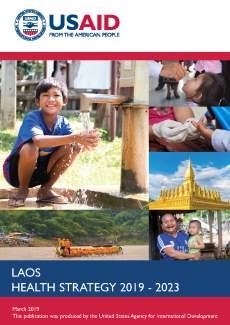Disclaimer: The authors’ views expressed in this publication do not necessarily reflect the views of the United States Agency for International Development or the United States Government.
Over the past 20 years, Laos has significantly reduced poverty and hunger and improved education and health outcomes. These successes have been driven by strong economic growth. The benefits of growth have, however, not been evenly distributed among the population. Poverty reduction has lagged significantly behind gross domestic product growth and has varied by location, education, ethnicity, sex, disability status, and occupation. Poverty—at 29 percent—is significantly higher in rural areas, compared to 10 percent in urban areas, pointing to a pronounced urban-rural divide. Communities from smaller ethnic populations, particularly in rural and remote areas, more commonly experience higher rates of maternal and infant mortality, stunting, and lower secondary school enrollment. The quality and coverage of health services nationwide remains low. Key challenges are limited access to health facilities in rural and remote areas, under-resourced and insufficient skilled health professionals, and underfunding of the health sector in order to achieve universal health coverage.
Laos’ key challenge is to utilize the country’s economic success to ensure sustained and equitable development that benefits the entire population. The Government of Laos (GoL) stands at a strategic intersection where it can choose between making sound investments to achieve its Sustainable Development Goals or go into even greater debt by borrowing for infrastructure projects that have limited potential to deliver on key development outcomes of benefit to the whole population.
To date, USAID’s health investments in Laos have been sporadic and scattered, and have taken place in the absence of an overarching, cohesive strategy. USAID supports a range of disparate health activities in Laos, many of which are managed outside the country and some of which are not linked to an overall strategic effort. As a result, this first USAID Health Strategy for Laos seeks to provide a cohesive vision for the Agency’s bilateral, regional, and central investments in the health sector, through building resilience and sustainable capacity and systems to overcome key barriers to development.
The development hypothesis that underlies this Strategy is that a healthy and well-educated population will foster resilient, equitable, and prosperous human and economic development for Laos.
A key aim of this Strategy is to improve health outcomes among Laos’ most vulnerable populations. The most vulnerable populations, as reflected in the health outcome data, are pregnant and lactating women, newborns, children under five years of age, and female adolescents, particularly those living in poverty in rural and remote areas who experience the worst health outcomes. Accordingly, USAID’s highest priority for health sector programming will be to support improved health and nutrition outcomes among mothers, newborns, children, and adolescents. This support will include activities to empower women and girls, increase equitable access to and utilization of reproductive, maternal, newborn, child and adolescent health (RMNCAH) and nutrition services and increase adoption of healthy behaviors and sustained optimal home-based practices and community norms related to RMNCAH, including improved Water, Sanitation, and Hygiene.
To achieve sustainable outcomes, USAID’s health programming will place a particular emphasis on strengthening systems to improve equitable universal access to health services. A key area of support will be enhancing the responsiveness of the health system to deliver quality RMNCAH services. USAID will also provide technical assistance to facilitate equitable and efficient financing of the health sector at all levels and support capacity development for improved management and governance of the health system at all levels.
High levels of vulnerability also exist among populations at greatest risk for infectious diseases, such as HIV, drug-resistant malaria, neglected tropical diseases, and emerging pandemic threats. USAID will continue to build on previous and current investments in these areas to strengthen the capacity of Laos to prevent, detect and respond to infectious diseases.
Persons with disabilities and mental illness are also among Laos’ most vulnerable populations due to social marginalization and a lack of social inclusion resulting from stigma and discrimination. This is reflected in the limited nature and availability of appropriate services. USAID health programming will focus on prevention of injury and disability, increased access to and utilization of rehabilitation and mental health services, promotion of disability inclusive health and social behavioral change, as well as fostering community integration.

